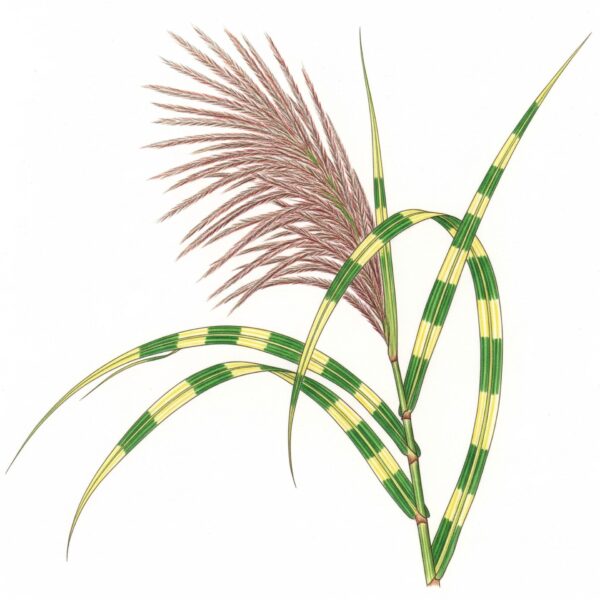Miscanthus sinensis ‘Zebrinus’, commonly known as zebra grass, is a striking ornamental grass widely grown in the UK for its distinctive foliage and architectural form. It is a deciduous, clump-forming perennial that provides significant visual interest throughout the year.
Description
Key Characteristics:
- Foliage: The most notable feature is its arching, linear green leaves with unique, creamy-yellow or pale-yellow horizontal bands. These “zebra stripes” typically become more pronounced as the growing season progresses, often appearing most vivid in late summer.
- Size and Habit: This cultivar grows in a fountain-like clump, reaching a height of 1.2 to 2 meters (4 to 6.5 feet) with a spread of around 0.5 to 1.5 meters (1.5 to 5 feet). Its graceful, weeping habit can sometimes cause it to flop, and in certain situations, it may require staking.
- Flowers: In late summer or early autumn, it produces silky, feathery plumes of flowers in shades of pink, silver, or light brown. These inflorescences rise above the foliage and persist through the winter, adding a dramatic presence and texture to the winter garden.
- Autumn and Winter Interest: The foliage turns a warm russet or tan colour in autumn, and the dry stems and plumes remain upright, providing structure and movement in the winter landscape.
Growing Conditions and Care:
- Sun and Soil: ‘Zebrinus’ thrives in full sun, which is essential for the best foliage colour and flowering. It is tolerant of a wide range of soil types, from sandy to heavy clay, but it requires moderately fertile, moist, but well-drained soil. It is important to protect it from excessive winter wet to prevent the roots from rotting. I have it in a clearing where it gets some sun within my woodland edge planting theme.
- Hardiness: This cultivar is fully hardy throughout the UK, able to withstand severe winter temperatures (RHS hardiness rating H6, down to -20°C).
- Pruning: As a deciduous grass, its old foliage and flower stems should be cut back to ground level in late winter or early spring, just before the new growth appears. This annual pruning rejuvenates the plant and ensures a fresh display each year.
Landscaping Uses:
- Architectural Interest: The strong vertical lines of its foliage and the graceful arching form make it a superb specimen plant or focal point in a border.
- Screening and Hedging: Its tall, dense clumps can be used to create an effective and attractive informal screen or hedge.
- Mass Planting: When planted in groups, it can create a soft, textural mass that adds movement and sound to the garden when it sways in the breeze.å
| See also different: | Easy-care perennial plants |

